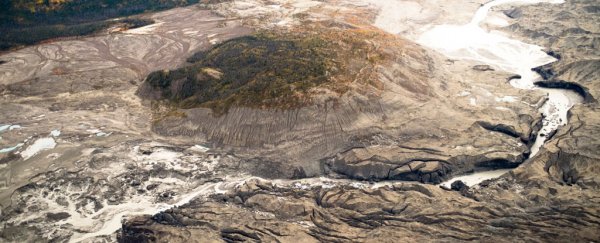For the first time in modern history, scientists have observed an entire river disappear in the space of days.
The phenomenon – called river piracy – is where one river's flow is captured by another. Historical evidence suggests it usually takes thousands of years for the process to occur, but in this case the Slims River fed by Canada's Kaskawulsh Glacier was co-opted in only four days – a timeframe researchers describe as "geologically instantaneous and… likely to be permanent".
"Geologists have seen river piracy, but nobody to our knowledge has documented it happening in our lifetimes," says geoscientist Dan Shugar from the University of Washington Tacoma.
"People had looked at the geological record – thousands or millions of years ago – not the 21st century, where it's happening under our noses."
Shugar and fellow researchers travelled to the Slims River on a fieldwork expedition in the Yukon last August, but when they arrived they found that Slims – which had a flow averaging about 480 metres (1,575 feet) wide previously – had all but disappeared.
"[T]here was barely any flow whatsoever. It was essentially a long, skinny lake," says Shugar.
"The water was somewhat treacherous to approach, because you're walking on these old river sediments that were really goopy and would suck you in. And day by day we could see the water level dropping."
River gauges indicated that water levels had dropped sharply between 26 and 29 May 2016. To examine where all the water had gone, the team surveyed the area using drones and a helicopter, and the culprit in this case of river piracy became apparent.
For the last 300–350 years, Slims River was fed by north-running meltwaters from one of Canada's largest glaciers, Kaskawulsh Glacier.
But with the glacier retreating in recent years due to Earth's warming climate, a period of intense melting saw the flow of meltwater punch a new channel in the ice, rerouting the flow southwards via the Kaskawulsh River.
What this means is that instead of ending up in the Bering Sea by way of Kluane Lake, the meltwater now runs in a south-east direction and eventually reaches the Pacific Ocean.
It's a massive turnaround – and not only because it's the first time that river piracy has happened so quickly, but because it's the first case where scientists think the phenomenon happened due to human-caused climate change.
"The event is a bit idiosyncratic, given the peculiar geographic situation in which it happened," says one of the team, John Clague from Canada's Simon Fraser University, "but in a broader sense it highlights the huge changes that glaciers are undergoing around the world due to climate change."
Although the areas surrounding the Slims River aren't heavily populated by humans, the researchers say the effects of the rerouting will have huge consequences on natural ecosystems – and could affect future water supply in the region.
"While one remote glacial river changing its course in the Yukon might not seem like a particularly big deal, glacier melt is a source of water for many people," geoscientist Rachel M. Headley from the University of Wisconsin-Parkside, who wasn't involved with the study, told The New York Times.
"[A]nd the sediments and nutrients that glacier rivers carry can influence onshore and offshore ecological environments, as well as agriculture."
Given the particular location of Kaskawulsh Glacier, the team suggests that other melting glaciers wouldn't necessarily produce similar instances of river stealing as they melt – but it could happen.
In any case, the phenomenon serves as another powerful reminder – in case we needed any – that the ramifications of global warming can produce dramatic and difficult-to-predict tangents.
"So far, a lot of the scientific work surrounding glaciers and climate change has been focused on sea-level rise," Shugar explains in a press release.
"Our study shows there may be other under-appreciated, unanticipated effects of glacial retreat."
The findings are reported in Nature Geoscience.
